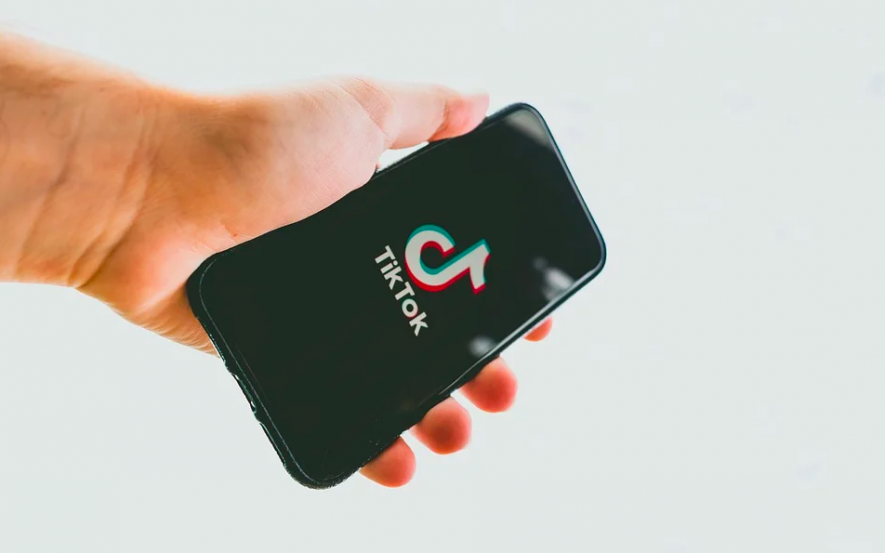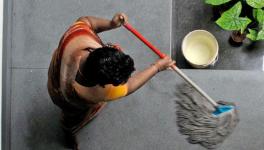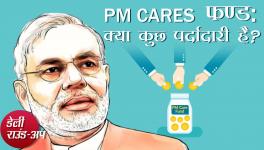Tik-Tok was a Platform for Our Talent and Gave Us Freedom, Say Domestic Helpers

Hair matted with sweat, Lakhi Pramanik (34) wiped her wet soapy hands on her drenched kurta as she picked her new smartphone to her ears. Irritated, she wiped the sweat off her screen and answered it in a high pitched tone, “Yes, yes, this is my last house for the day. I will then meet you guys on the terrace to shoot a Tik-Tok video.”
She kept the phone and hurried back to rinse the rest of the utensils lying in the kitchen basin, for it was 4 PM and Tik-Tok time.
Seeing Lakhi in a rush, her employer queried on whether her family of four children and an ailing mother were okay. But Lakhi replied with a smile, “Yes, yes, I am off to make Tik-Tok now. Do you want to see my collection of clothes?”
She opened her shiny black bag and carefully placed her new smartphone--which she bought solely for Tik-Tok after working multiple extra shifts for a year--inside it. Then she took out a pair of jeans and a bright coloured top with an earring to go.
“I like wearing western clothes, but where I live, married women are not allowed to do so. On top of that, I am a widow,” she said.
With over 119 million users, Tik-Tok was one of the most popular video apps among a large section of the working-class population. Some like Lakhi, bought new android phones and accessories to be able to create their Tik-Tok videos, which led to a massive increase in their sales.
For Lakhi, Tik-Tok was not just a performative platform with just a bunch of people as followers, it was what she did to feel free. “Nobody judges me or my clothes on Tik-Tok. Instead, I get good comments. It sometimes feels like a stress buster,” she said.
She had at least 2,000 fans on the Chinese app, Tik-Tok, which was one of the 59 apps to be banned by the Government of India, following increased tensions with the neighbouring after 20 soldiers were killed at Galwan valley. According to the government and many news media organisations, this was a digital retaliation.
The destination for small mobile videos, Tik-Tok is owned by a Beijing-based internet company, ByteDance Ltd. and launched its services in India in 2017. Since then it’s fan base had grown to 119 million active users.
Also read: 85% Domestic Workers Not Paid During Lockdown, Says Survey
It’s simplicity, large scale publicity encouraged many to join these active users team, according to Ratul Chatterjee (22), a Tik-Tok user and a dancer from Kolkata, “The fun part was that most of the viewers were also creators. What’s interesting is that all classes came together in this app, unlike YouTube and Instagram. We witnessed people from marginalised household shine, even women.”
Before Tiktok, Namita Roy (30), Lakhi’s sister, used to pursue her passion for singing on Smule, “I could not see my face or expressions. I switched to Tik-Tok for larger visibility and the features,” she said.
Lakhi did find recording the videos with added features and effect troublesome at first, but slowly she was hooked to it. “The reason I never uploaded a video on Facebook was that I have my in-laws and acquaintances in my friend list. YouTube was too complicated and unyielding. I don’t know what is Instagram?” she asked.
She was 29 years old when she lost her husband and decided to move back to her mother’s home in Chandpur, with her two children. Immediately after that, she lost her elder sister and despite regular cash crunch, decided to share her small bamboo house with her nephew and niece. She now is the sole provider to four children and her ailing mother.
“Initially, I used to be scared always, even to be on Tik-Tok, too. For what if my in-laws see the videos and make it an issue. But Namita and Rupa stood like a pillar and helped me calm my nerves,” she said.
Every day after 4 PM, Rupa, Lakhi and Namita met to change from their work clothes, apply make-up and get to making videos. Unlike Lakhi, Namita and Rupa used to make videos at home, too. “My husband didn’t like me making videos, so I used to make some before he came home from the day’s work,” said Rupa.
Namita Roy (30) and Rupa (34) are also domestic workers in the same vicinity.
But, on June 29, she received an urgent call from Namita, who sadly announced the ban on Tik-Tok and 58 other Chinese apps, to Lakhi.
Unaffected by the ban on other apps, Lakhi was shocked to hear Tik-Tok’s name on the list, she immediately opened her app to check the news. “All my videos had vanished,” she said, and called Rupa to inform her.
Also read: App Ban: Uphold ‘Legitimate and Legal Rights’ of International Investors, China Tells India
An expert at Tik-Tok, according to Lakhi, Rupa had 3,000 fans in a year. And after hearing the news, Rupa’s immediate reaction was, “If the app starts working, will I be able to watch those videos again?”
“Rupa was always the funny one. So when she started making comedy videos, she sometimes used to get likes in thousands,” recalled Lakhi.
A mother to a 14-year old boy, Rupa is expecting another child and is popular amongst her employers as ‘Ms. Funny Bones’. “Considering, where I am in life, where I come from, I don’t think I will ever be able to go and act in a TV soap opera. So we used to feel happy and content to see our faces pop on screen and watch the number of likes grow and see people approve of our work,” said Rupa, adding, “Tik-Tok was a platform for our talent and our desire.”
On whether banning Tik tok was the right decision by the state, Rupa said, “If because of Tik-Tok, India is at a loss. Then ban it. If not, then why?”
However, Namita said, “Why just Tik-Tok and 58 other apps and how is it justifiable? There are so many items that we get from China, what about them? The phone that I have is Chinese, the television that I watched this news on is Chinese, and some of the toys with which my daughter plays is also Chinese. Then, how is banning Tik-Tok protecting us? And I don’t understand why the government is so crazy about just the apps,” adding, “Also if they do ban the sale of Chinese products, do we have Indian products to replace it with?”
The author is an independent journalist.
Get the latest reports & analysis with people's perspective on Protests, movements & deep analytical videos, discussions of the current affairs in your Telegram app. Subscribe to NewsClick's Telegram channel & get Real-Time updates on stories, as they get published on our website.

















